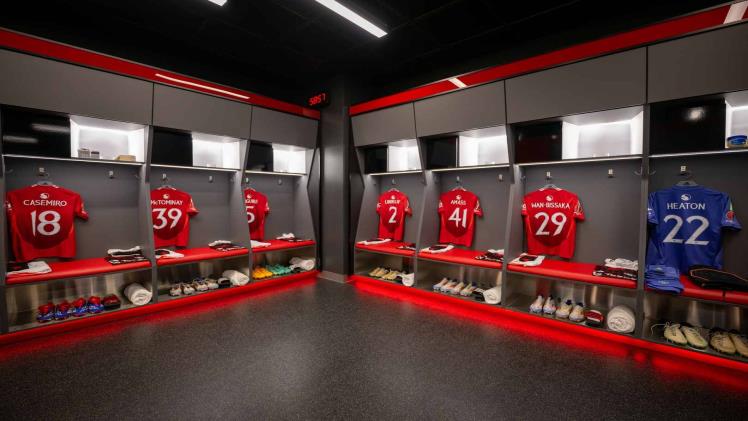Inside Manchester United Dressing Room: History, Culture, and Legacy
In football, the dressing room is not just a space where players prepare—it is the heart of a club’s identity. Strategies are drawn, bonds are forged, rivalries are settled, and victories begin in these hidden sanctuaries. Dressing rooms embody both the physical and symbolic essence of a team.
Among the most iconic in world sport is the Manchester United dressing room. To understand its meaning today, we must follow its journey from the modest facilities of Newton Heath and Bank Street to the legendary and modernized spaces of Old Trafford.
Early Dressing Rooms at Newton Heath and Bank Street
Manchester United’s story began in 1878 as Newton Heath LYR Football Club. At their first ground, North Road, there were no real dressing rooms. Players often changed in nearby pubs or railway buildings before walking to the pitch. These modest beginnings reflected the working-class roots of the team.
When the club moved to Bank Street in Clayton in 1893, facilities slightly improved. The stadium had basic wooden stands and rooms where players could prepare, but conditions remained poor. Flooding, mud, and cramped spaces made preparation difficult.
These humble facilities emphasized the need for a permanent, professional home—a demand answered with the construction of Old Trafford in 1910.
Old Trafford’s First Dressing Room Facilities
When Old Trafford opened in 1910, it was hailed as a modern marvel of football architecture. Designed by Archibald Leitch, it included structured dressing rooms that set new standards for the club. Players finally had proper spaces for preparation, complete with showers and benches.
The sequence is clear: crude beginnings at North Road → modest progress at Bank Street → professional facilities at Old Trafford. This progression mirrored United’s growth from a local railway team to a professional football club.
Yet the facilities did not remain untouched. World War II brought destruction to Old Trafford, and the dressing rooms were no exception.
Post-War Reconstruction and Upgrades
In 1941, German bombing raids during the Manchester Blitz severely damaged Old Trafford. The stadium, including its dressing areas, was left unusable. For nearly a decade, United played home games at Maine Road, sharing with Manchester City.
After the war, Old Trafford was rebuilt and reopened in 1949. The dressing rooms were upgraded with improved showers, lighting, and treatment areas. These innovations reflected both the club’s resilience and ambition.
Evidence repeated itself: just as the team recovered from setbacks on the pitch, the dressing room rose again from wartime destruction. This resilience became part of Manchester United’s cultural DNA.
The Ferguson Era and Dressing Room Mentality
By the late 1980s, under Sir Alex Ferguson, the dressing room became more than a physical facility—it became a cultural fortress. Ferguson recognized that the atmosphere inside the room was as critical as tactics.
Known for his “hairdryer treatment,” Ferguson used the dressing room to enforce discipline and inspire determination. Under his reign, the Manchester United dressing room symbolized intensity, respect, and unity.
It was here that legends like Ryan Giggs, Eric Cantona, Roy Keane, and Paul Scholes prepared for matches that would shape football history.
Leadership, Rivalries, and Team Bonding
The dressing room culture was defined by leadership. Roy Keane’s authority, Ryan Giggs’s longevity, and Paul Scholes’s quiet influence created a dynamic balance. Rivalries between players sharpened competition, while shared moments forged lifelong bonds.
These related attributes—discipline, rivalry, unity—directly translated into dominance on the pitch. The trophies of the Ferguson era were not only won in stadiums but also shaped in the atmosphere of the dressing room.
Modern Dressing Room Layout and Technology
Today, the Manchester United dressing room at Old Trafford has been transformed into a high-tech facility. Renovations in the 2000s introduced larger spaces, individual lockers, hydrotherapy pools, and physiotherapy zones. Digital screens allow for tactical briefings and instant match analysis.
Statistical evidence shows United invested millions of pounds into modernizing Old Trafford’s facilities, ensuring they meet elite standards. The room now blends tradition with innovation, creating a space worthy of global superstars while preserving historical symbolism.
Comparison with Rival Clubs’ Dressing Rooms
Comparing United’s dressing room with rivals highlights its unique balance.
- Manchester City (Etihad Stadium): sleek, circular design that emphasizes equality and technology.
- Liverpool (Anfield): recently modernized, blending heritage with modern convenience.
- Real Madrid (Santiago Bernabéu): minimalist, futuristic, focused on luxury and tactical analysis.
The comparison shows Old Trafford’s distinction: it may not be the newest, but its weight of history adds cultural meaning no modern facility can replicate. United’s dressing room balances legacy with progress.
Symbolism of the Manchester United Dressing Room
The Manchester United dressing room symbolizes resilience, identity, and tradition. It is the unseen arena where legends prepared, where emotions surged before and after defining matches, and where cultural values were reinforced.
For fans, it represents the spiritual core of the Theatre of Dreams. This symbolism extends into wider football culture, where supporters connect through stories, digital platforms, and even communities like ufa168 เข้าสู่ระบบ, which allow fans to immerse themselves in narratives of football heritage and identity.
Fan Tours and Access Behind the Scenes
One of the most unique opportunities for fans is access to the dressing room during Old Trafford stadium tours. Visitors can step into the same room where legends like Cristiano Ronaldo or Wayne Rooney once prepared.
This unique value opportunity transforms history into living memory. Fans often describe the experience as emotional and surreal, turning a hidden sanctuary into a shared cultural experience that connects supporters across generations.
Legacy of Manchester United’s Dressing Room
From the crude facilities of Newton Heath and Bank Street to the modern sanctum of Old Trafford, the Manchester United dressing room has evolved into one of football’s most iconic spaces. It embodies resilience through war, ambition through modernization, and unity through culture.
Its legacy lies not only in physical design but in the memories and values it represents. For fans, this story extends beyond Old Trafford, connecting with broader sports culture through digital platforms like ufabet เว็บไหนดี, where passion for football and entertainment continues to thrive.
In conclusion, the Manchester United dressing room is more than four walls. It is a living monument to history, culture, and legacy—an unseen stage where greatness was prepared and where the values of a footballing giant continue to be forged.







